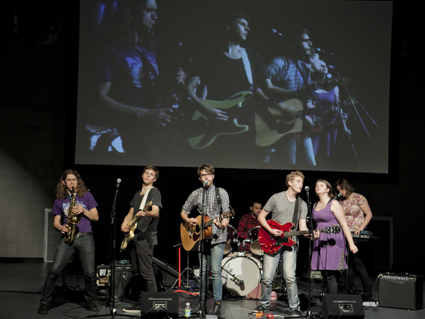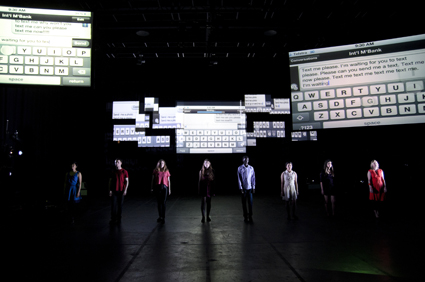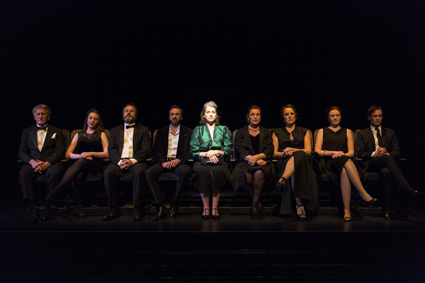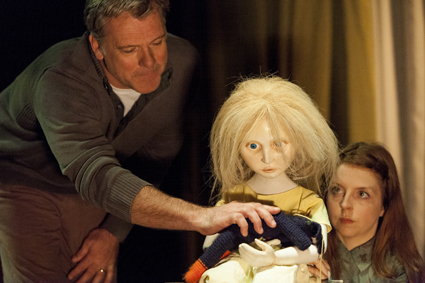mysteries of conception & execution
keith gallasch: appelspiel, version 1.0 & atyp, stc

Applelspiel Make a Band and Take on the Recording Industry
photo Alina Gozin’a
Applelspiel Make a Band and Take on the Recording Industry
PERFORMANCE IN ALL ITS DIVERSITY GREETED ME IN THEATRES OVER RECENT MONTHS: A HORROR STORY IN WHICH A FATHER IS NEARLY DRIVEN TO MURDER HIS CHILD (PRESENTED AS A NASTY PUPPET); AN ADAPTATION OF AN INGMAR BERGMAN SCREENPLAY IN WHICH A PSYCHIATRIST, INCAPABLE OF SELF-ANALYSIS, SUFFERS A SEVERE NERVOUS BREAKDOWN; A YOUTH THEATRE PRODUCTION THAT ADDRESSES STRESSES AND CULPABILITIES IN GOSSIP CULTURE; AND, THANKFULLY LIGHTER, AN ENSEMBLE OF PERFORMERS FANTASISE A ROCK’N’ROLL CAREER FOR THEMSELVES. EACH OF THE WORKS RAISED DRAMATURGICAL ISSUES AROUND CONCEPTION AND EXECUTION.
appelspiel make a band…
Appelspiel’s ‘rockumentary,’ Applelspiel Make a Band and Take on the Recording Industry is an amiable satire on the popular music industry via video interviews, performances, video clip mockups, the tour saga and the pressures that can result in band breakup. It’s all too familiar territory but what gives this show an edge is the inclusion of local colour autobiographical material captured in onstage video interviews, the tracking of the construction of hoped-for hit songs, including different arrangements, and, at the work’s dramatic centre, an hilarious roundtable battle over royalties caught verité onscreen by a camera amid the performers.
What impresses is the precision and ease with which the creator-performers manage the constant juggling of cameras, microphones, musical instruments and scene setting. The band members are their own very efficient roadies. A pity then that the overall lighting lacks definition, frequently blurring the projected images on the large screen that dominates the stage. Handheld lights and clever camera work create some of the best effects including a very funny parody of a hip hop video clip which managed to transfer well to the screen.
Appelspiel Make a Band and Take on the Recording Industry is an inventive and very funny crowd pleaser. It deserves a return season with the opportunity to smooth out unevennesses in the singing and the otherwise admirably laidback performances, to improve the rather limp ending and to trim the number of songs. Appelspiel Make a Band…represents a quantum leap in the writing, structure and performance strengths of the group; promise of even better things to come.
atyp and version 1.0, the tender age

The Tender Age, ATYP & version 1.0
The inspiration for The Tender Age comes from an infamous radio broadcast in which a young teenager, quizzed about her sexuality on radio, reveals that she has been raped, and that her mother had refused to deal with it. That the girl was even being interviewed about her sexuality by radio hosts Kyle Sandilands and Jackie O using a lie detector was bad enough, but the role of her mother, who thought it would be good for the girl to be confronted about herself in a public arena, was more worrying. The mothers and other adult women in The Tender Age are, by the end of the performance, grotesques.
Against projections of images of a household interior on large screens, a very long period is spent establishing the mood of a group of teenagers, dancing, cuddling and playing games until a mobile phone image of one of the girls having sex is widely distributed. The young performers move in straight lines, breaking at right angles, rumour and judgments passing from one person to another. Screens fill with faces and keyboards. Abusive exchanges ensue. The radio interview is recreated verbatim: Jane Phegan plays the mum neutrally so it’s difficult to judge the woman’s tone and motives—but she’s the one who asks the lie detector questions. The radio hosts are immediately alarmed and apologetic. The scene is deftly realised; judgment left to the audience.
A woman appears, anxious about choosing the right image of herself for Facebook. A restrained teenager worries about kissing. A counsellor struggles to effect a meaningful apology from the student perpetrator of e-gossip. This is another strong scene, rich in tensions and contradictions, if too short-lived. The plethora of images and information in The Tender Age have by now evoked both the vulnerability and cruelty of teenagers, but evocation is rarely extended to anything more probing.
Images and episodes roll on. A witty ode to the smart phone is followed by a human tangle in which, among other things, the percentage of teenagers watching porn is detailed. A woman is outed online and loses her job for sleeping with her CEO. With a row of alco-pops before them, the adolescents express their anger at adult hypocrisy about alcohol consumption. Finally, drunken mothers turn against their children: “You’re a loser, just like your father,” “You ruined my life. I wish you didn’t exist.”
Where are the fathers? Or is this a single mother issue? The young people, whose material this is have, to a large degree, cast their net very wide resulting in an intermittently engaging show with some tantalisingly potent scenes and confusing disjunctions. On the other hand, the narrowness of the approach to adult females (anxious, vain, ineffectual, victimised, drunken and bitter) calls at the very least for a sustained scene depicting a mother-child relationship.
Fortunately the committed young actors perform convincingly and passionately under the co-direction of Fraser Corfield and David Williams, although some standard youth theatre gambits and the cut and paste construction of content is not what we expect, especially from version 1.0. Given the delicacy and the potency of the subject matter, The Tender Age warranted an experienced writer to help draw its young subjects further into the complexities of the issues they face in their lives. This is a very well-publicised production of scale in a major venue; its young performers deserve more. The Tender Age certainly holds up a mirror to the lives of a generation, but much more than reflection is needed.
stc: face to face

Face to Face, STC
photo Brett Boardman
Face to Face, STC
Without having first seen Ingmar Bergman’s Face to Face (1976), director Simon Stone found the published screenplay and was entranced by its theatrical potential. Bergman was also a great director of the European stage, a ruthless adaptor (like Stone) of classics and, apparently, a not particularly successful playwright. It was, of course, in film that Bergman excelled as a writer, innovatively synthesising theatre and cinema into what he described when referring to Persona, The Silence and others as “chamber films.’
As a fan of Bergman’s films, Stone was aware of a problem, one that the filmmaker himself was constantly alert to (and had written about pre-production to the actors and crew for the Face to Face): how to represent dreams in film? Bergman regarded this film, one of his least favourite, as emotionally overwrought. The film is nonetheless absorbing, largely due to the raw power of Liv Ullman’s performance as Jenny, a psychiatrist suffering a nervous breakdown; but the extended dream sequences are indeed problematic—rather theatrically staged and too literally symbolic. However, Bergman gets it right in the smaller moments of psychological disintegration in Face to Face when the bleed from reality to hallucination appears frighteningly actual, a goal Bergman aspired to. These involve Jenny’s encounters with an elegant, elderly woman, dressed in black and missing one eye. That she is so disturbed by the woman, with whom she exchanges no words, is the first signal for Jenny that something is wrong. Later she will turn to a mirror and see not herself, but the one-eyed woman.
Co-adaptors Stone and Andrew Upton have elided the old woman, perhaps because her role is purely symbolic and too neatly frames both screenplay and film. In doing so they diminish, to a degree, Bergman’s Freudian preoccupations and focus on immediate social pressures—work, marriage, ageing relatives—and rape. This makes things awkward when, in the play’s second movement (there is no interval) in a psychiatric ward, the “repressed” fairly gushes out in an expository rush. It’s already a problem in the original and no less so here. What Stone and Upton do tolerably well, however, is realise a disturbing interplay of nightmare and reality in the ward.
Jenny’s hospital room is a wide, glaringly white box of a room behind glass with the actors’ voices cinematically amplified, lending the production the much needed chamber theatre quality it most certainly needs. Between moments of lucidity, Bergman’s screen nightmares are replaced by hallucinated characters from Jenny’s life who, confronting and demanding, wander into or race through her room. The success of these scenes, played out in a shifting palette of eerie pastel lighting that blurs the rational/irrational divide, highlights the weakness of the first movement of Face to Face.
Stone uses the full, bare stage of the Sydney Theatre for the first half of the play in which Jenny’s world disintegrates, placing performers at a great distance from the audience and each other. While Stone’s skill at stage choreography can never be doubted in the enforced intimacy of Belvoir Upstairs, here it appears, at turns, shapeless or over-determined. Voices are thin, furniture (including an embarrassingly voluminous hot tub) is clunkily hauled on and off. Perhaps Stone reckoned that this otherwise vast emptiness would amplify our sense of Jenny’s alienation from her world. The one moment of intense focus in the first movement comes when, after being raped, Jenny attends a musical concert. The actors sit in a row across the front of the stage, Jenny arriving late and sitting in the middle, her face alone is spotlit.
For Bergman, the still face in close-up was one of his principal filmmaking fascinations. In theatre, lighting aside, it’s the actor’s capacity physically and vocally to draw us to them with the aura that is their personal spotlight—witness Cate Blanchett’s Lotte in the opening monologue of STC’s Gross und Klein. But there’s little opportunity for that in the first rather disengaged first movement of Face to Face, save for moments of wry if incidental humour. However, in the end—as it should be—it’s the performances—if against the odds and principally in the second half—that make Face to Face memorable.
Kerry Fox’s down to earth Jenny is a superb realisation of a woman for whom every meaningful connection with the world is systematically severed. She plays the role with a lightness of touch, a kind of innocence tempered with touches of bluntness and detachment. But it is an innocence corrupted by denial. Without going to the physical extremes of Liv Ullman’s body-wrenching breakdown in the film Fox nonetheless conveys a palpable sense of total disturbance.
Having left a phone message for her husband, describing the vacuousness of her reality, and consumed copious sleeping tablets, Jenny slips into another world signalled by a column of light emanating from a vast ceiling descending from above and into which she disappears. After a short blackout we are with her in the nightmarish psychiatric hospital in the play’s second movement. The effect is theatrically monumental, possibly ironic, but oddly epic in proportion to the movements that frame it and certainly an unsubtle leap from the real into nightmare.
There are too many changes to the Bergman screenplay to warrant detailing, some are clever, some insightful, some wrongheaded. Bergman’s theatre metaphor is nicely accentuated. However, it’s quite noticeable that lines that work on screen in close-up can sometimes sound either bland or melodramatic when transferred wholesale to the stage, especially when juxtaposed with fresher additions from the co-adaptors. Mitchell Butel’s Thomas, a bisexual with whom Jenny has a brief affair and who supports her through her illness, is denied the mix of altruism and cynical resolution he exhibits in film and screenplay. It makes him too benign, undercutting Jenny’s return to strength and independence. Butel’s is a fine performance but deserving more complexity. Wendy Hughes and John Gaden as Jenny’s aunt and uncle are excellent and Humphrey Bower is aptly acerbic as a cynical fellow psychiatrist. Face to Face is partly successful, thanks mostly to Kerry Fox’s central performance, but the adaptation appears to have created more problems than it could solve.
stc: hilary bell, the splinter

The Splinter, STC
photo Brett Boardman
The Splinter, STC
Hilary Bell’s The Splinter, the tale of a kidnapped child mysteriously returned to her parents, has the potential to unnerve its audience, but something appears to be awry in conception and execution.
The return should be the salvation of her parents’ difficult relationship but the father doubts the child is their own. His growing paranoia in which he hallucinates two sinister look-alike teenagers in cahoots with the imposter turns him against mother and child. What ensues is confusing narrative and theatrical overload.
In the tradition of the folk tale and ghost story, something very odd is happening, which even the wife momentarily experiences, but it doesn’t help the audience place the apparently evil twins, other than as ‘the others.’ The father sees them as manipulating his family. This is amplified by the others’ Bunraku-style handling of the child, presented as a puppet. Had the production invested more in the realisation of the child, given it a more palpable personality, as puppetry is perfectly capable of, and more engagement in the action, then the production might have offered Erik Thomson much more to work with. The child is absent for long stretches and her presence is diluted when she’s simply bundled about by the twins. I began to wish that the two were simply puppeteers (much to be learnt here from My Darling Patricia’s virtuosic Africa, RT101, p41) instead of being literalised and attention pulling. ‘The others’ should be felt and not seen. And the child should dominate the stage life of her parents.
Erik Thomson (ideally cast as a benign man pushed to the edge of madness and possibly the murder of his child) and Helen Thomson (a principally reactive role, but excellent in the moment where she grapples with her guilt) do their best under difficult circumstances. It’s a pity that The Splinter becomes so confusingly diffuse when it appears to have the potential to chill.
In RealTime 112, Andrew Fuhrmann will write about a Melbourne adaptation of Ingmar Bergman’s film Persona from Fraught Outfit and Theatre Works; it’s programmed for Belvoir in July-August, 2013. An interview with Simon Stone about Face to Face appeared in RealTime 110. An interview with Hilary Bell can be found here.
–
Performance Space, Show On: Appelspiel Make a Band and Take on the Recording Industry, creator-performers Simon Binns, Nathan Harrington, Nikki Kennedy, Emma McManus, Joseph Parro, Troy Reid, Rachel Roberts, Mark Rogers; Carriageworks, July 25-28; version 1.0 & Australian Theatre for Young People, The Tender Age, directors Fraser Corfield, David Williams, performers ATYP members, video artist Sean Bacon, lighting Christopher Page, sound design Gail Priest, Carriageworks, Aug 22-Sept 1; Sydney Theatre Company, Face to Face, A Film by Ingmar Bergman, director, adaptor Simon Stone, co-adaptor Andrew Upton, cast Humphrey Bower, Mitchell Butel, Kerry Fox, John Gaden, Wendy Hughes, Anna Martin, Jessica Nash, Queenie Van Zandt, Dylan Young, set and lighting Nick Schlieper, costumes Alice Babidge, composer, sound design Stefan Gregory, Sydney Theatre, opened Aug 11; Sydney Theatre Company, The Splinter, writer Hilary Bell, director Sarah Goodes, performers Julia Ohannessian, Erik Thomson, Helen Thomson, Kate Worsley, puppetry, movement director Alice Osborne, designer Renee Mulder, lighting Damien Cooper, composer Emily Maguire, sound design Steve Francis; Wharf 1, STC, Sydney, Aug 10-Sept 15
RealTime issue #111 Oct-Nov 2012 pg. 44-45






